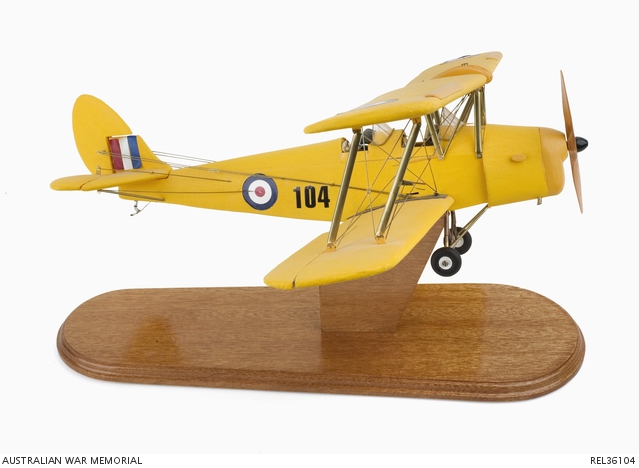| Place | Oceania: Australia, New South Wales, Sydney, Mascot |
|---|---|
| Accession Number | REL36104 |
| Collection type | Technology |
| Object type | Model |
| Physical description | Aluminium, Balsa wood, Brass, Paper, Rubber |
| Maker |
Bracey, Harold Pearce |
| Place made | Australia |
| Date made | c 1980 |
| Conflict |
Second World War, 1939-1945 |
Model of a DH 82 Tiger Moth : Flight Lieutenant H P Bracey, RAAF Instructor





Hand made wooden model of a DH 82 Tiger Moth biplane in approximately 1:16 scale, painted overall in yellow and displaying the serial 104. Struts, rigging undercarriage, windscreen frames, fuel tank and rear tail skid are all from brass; the body, wings and tail are from balsa and the entire body has been covered in yellow fabric. Roundels and tail flashes are realised with decals. The propellor is carved from wood and the plane sits on rubber tyres. The model is mounted on an angled wooden base which gives the plane an attitude of flight. Written in ink under the base are the words ' This is a model of DH 82 Tiger Moth in which H P Bracey (Flt Lt) went solo on 4/10/1941 at Mascot, NSW - No 16 Course EATS. His instructor at that time was S/L John Kingsford-Smith'.
Made by Harold Pearce Bracey, born Marrickville, NSW, on 30 November 1919. Bracey enlisted with the Royal Australian Air Force (RAAF) on 21 June 1941 and served under service number 411855. He commenced training at No 4 Elementary Flying Training School (4EFTS), Mascot, taking his first flight in a DH-82 Tiger Moth on 22 September 1941 under the instruction of 260596 Flight Lieutenant John Kingsford-Smith. One of the Tiger Moths he flew regularly (nine times, according to his log books ¿ see PR03779) was A17-104, the aircraft he reproduced as a model, and in which he first flew solo. Upon completion of this course, Bracey moved to 3 Service Flying Training School (3SFTS) at Amberley, Queensland in November 1941, where he trained on Avro Ansons until the end of March 1942, and, being rated as an exceptional pilot, commenced training as an instructor with the Advanced Training Squadron the following month. He started training at Central Flying School (CFS) towards the end of April 1942, about the same time that CFS moved from Camden to Tamworth, NSW, and attended 17 Elementary Flying Instructors Course. Promoted to Sergeant, Bracey commenced as a flying instructor with 5 Elementary Flying Training School (5EFTS) at Narromine on 10 June 1942, training pupils on Tiger Moths. In November 1943, Bracey converted to Wirraways and by the end of the month was instructing on these aircraft; he was transferred to 5 SFTS in early December 1943. One of the Wirraways he flew during this period (on 15 October 1944, on three occasions) was A20-103, the only Wirraway credited with shooting down a Japanese Zero. This Wirraway is now in the Memorial's collection (see RELAWM31891.001). Promoted to Flying Officer and then Pilot Officer during 1944, Bracey converted to Kittyhawks between July and September 1945 at 8 Operational Training Unit, Parkes, NSW. He was discharged on 27 September 1945.